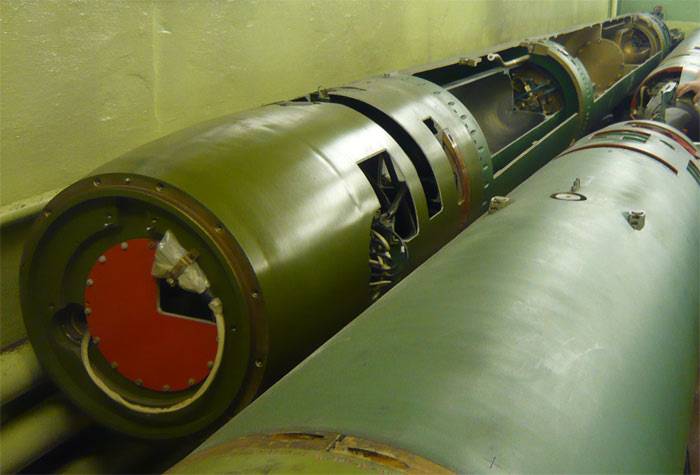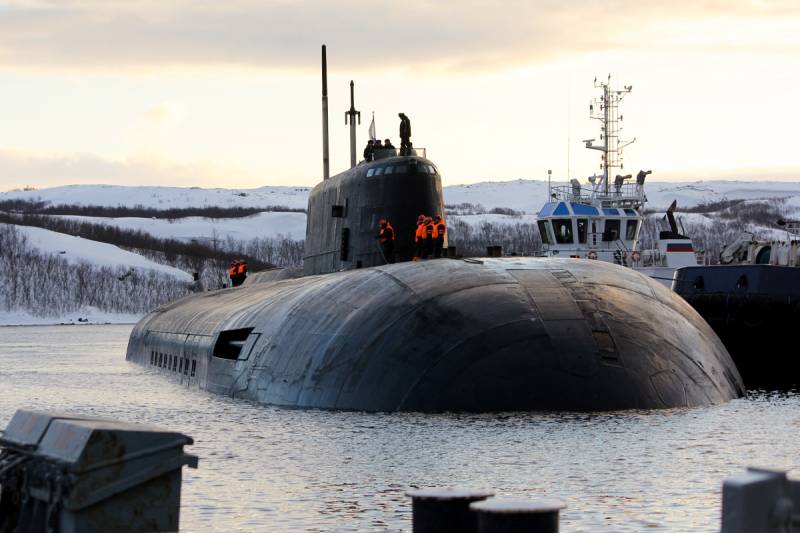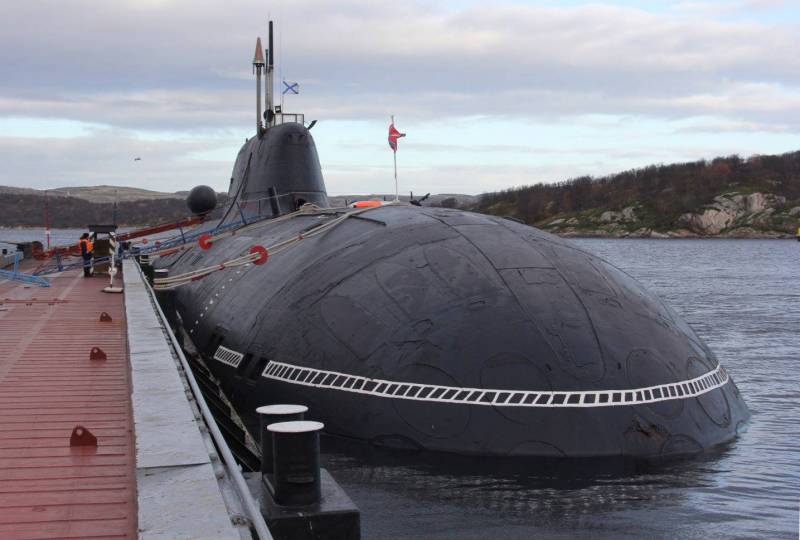Unique Russian torpedoes 65-76 and 65-76А
Need to remind history 650-mm torpedoes. Works in this direction started in the late fifties and had a specific goal. The command requested to create a promising torpedo, characterized by the highest range of travel and capable of carrying a special combat unit. It was assumed that such a torpedo could be launched outside the enemy's anti-submarine defense, and she could destroy the whole naval formation in one blast.
The development of the project was entrusted to SRI-400 (now the Central Research Institute "Gidropribor"). The chief designer was appointed V.A. Kaleynikov. Serial torpedo production was subsequently mastered machine-building plant them. Kirov (Alma-Ata). With the development of the project and the emergence of new types of weapons, the project participants did not change.

Split torpedo mockup 65-76. Photo Militaryrussia.ru
It was quickly enough that it was determined that the nuclear warhead simply did not fit into the body of the standard caliber 533 mm, because of which this parameter had to be increased to 650 mm. In 1961, tests of a promising nuclear torpedo began, taking several years. Checks ended in the 1965 year, but there were no carriers for the torpedo yet. Only in 1973, this weapon was adopted by the fleet and was included in the standard ammunition submarines. In accordance with the adopted system of notation, a new long-range torpedo was called the 65-73. The first number indicated the caliber in centimeters, the second - the year of adoption.
With all its advantages, the 65-73 product had a characteristic disadvantage in its limited scope. As a result, in the 1969 year, after completion of the main work, it was decided to develop a non-nuclear modification of the existing torpedoes. As before, it was possible to obtain the highest technical characteristics, and a different combat unit, despite the much lower power, still allowed to show high combat effectiveness.
Work on the new-type torpedo continued until the mid-seventies. After completing all the tests, the product was put into service under the name 65-76. In the course of finalizing the project in accordance with the new wishes of the customer, the torpedo received not only the conventional warhead, but also an upgraded guidance system. Thus, playing in some combat characteristics, the new torpedo 65-76 bypassed the base 65-73 in others.
By the early eighties in the USSR, a program was launched for the construction of new nuclear submarines belonging to the conditional third generation. In accordance with the plans of the command, such ships were supposed to save powerful torpedoes of caliber 650 mm. At the same time, the use of 65-76 products in their current form was considered inexpedient. To arm the new submarines, an updated and improved torpedo was required. The order to start its development came at the very end of 1982.
Designing a torpedo again engaged Central Research Institute "Gidropribor"; This time the chief designer was B.I. Lavrishchev. Option torpedoes 65-76 for third-generation submarines identified as 65-76A. In addition, the product was given the name "Whale". The project did not envisage a large number of changes, due to which its development took only a few months. Already in the year 1983 managed to hold the first test shooting. However, in the future work to some extent delayed. Checks ended only in the early nineties. The order to take the 65-76A torpedo into service and to deploy its mass production appeared only in the spring of 1991.
The 65-76 and 65-76А non-nuclear torpedoes were variants of the further development of the same basic design, as a result of which they have a lot of common features. At the same time, the two products differed in certain features of a technical and operational nature. Despite the differences, the main characteristics of the two torpedoes were at the same level.
Both products have a traditional torpedo cylindrical body with a hemispherical head and conical aft. Behind the stern constriction are several rudders and jet propellers made using longitudinal beams. The layout of the case is classic. At the head of the instrument compartment are placed and the charging compartment, a large central part is given for fuel, and in the stern are the power plant and steering machines.

Product Scheme. Drawing Weaponsystems.net
According to known data, two torpedoes were completed with active homing systems that determine the wake of the target trail. This system was based on units borrowed from domestic torpedoes of previous models. In the framework of the “Whale” project, management tools were not seriously developed. Both torpedoes did not have remote control means and had to search for the target on their own.
Before firing, the 65-76 and 65-76 products were supposed to receive information from the ship’s fire control devices. In an earlier project, a mechanical input method was used — the torpedo received information through special spindles. The "Keith" product received an improved electrical system based on a set of contacts.
Both torpedoes belong to the thermal class and use a gas turbine powerplant. They are equipped with a heat peroxide turbine engine type 2DT. This product was developed in the research institute "Morteplotekhnika" in the mid-sixties and has already been used on some domestic torpedoes. The engine used hydrogen peroxide as a fuel and gave out more power to the HP 1430 HP. Due to the high power and significant fuel supply, such an engine allowed us to obtain a fairly high speed with outstanding ranges.
The torque of the gas turbine was issued to the impeller of the jet propulsion, placed inside the annular channel. Control over the course and depth is carried out using several planes placed directly in front of the jet.
Torpedo 65-76 received a charging compartment with a non-nuclear charge mass 500 kg. According to some reports, the correct choice of explosives allowed us to obtain a power equivalent to 760 kg of TNT. According to some sources, along with other new units, the upgraded torpedo 65-76А “Kit” received an increased charging compartment, due to which the mass of explosives was increased by 55-60 kg.
Both torpedoes had a diameter of 650 mm and a total length of 11,3 m. The older product 65-76 had a mass of 4,45 tons. According to sources indicating an increase in the ammunition during modernization, the newer “Kit” had a mass of 4,75 tons.
During the tests, launches of 65-76 torpedoes were carried out from depths to 150 m. In this case, the possibility of firing at depths to 450-480 m was declared. The speed of the carrier during firing is limited by 13 nodes. A power plant of sufficient power allowed both torpedoes to reach speeds up to 50 units. At maximum speed, the range reaches 50 km. Reducing the speed to 30-35 km / h can double the range. The torpedo goes to the target at a depth of 14 m.

Submarine "Eagle" project 949A - one of the carriers of torpedoes 65-76А. Photo of the Ministry of Defense of the Russian Federation
The first carrier of the newest torpedo 65-76 was the nuclear submarine K-387 of the project 671РТ "Salmon". In the nose compartment of this ship were two torpedo tubes of caliber 650 mm and four 533-mm systems. A total of seven such submarines were built. Next was built 21 submarine project 671РТМ. All of these ships belonged to the second generation and could use only two types of torpedoes: 65-73 and 65-76.
Further development of the submarine fleet led to the construction of third-generation boats, as well as the development of the modernized torpedoes 65-76А. One of the first submarines of the next generation capable of carrying torpedoes "Keith", became the ships of the project 671РТМК. As part of this project, the Navy added five combat units.
Also a couple of torpedo tubes of caliber 650 mm should have been carried by the submarines of the 945 “Barracuda” project. Curiously, the following projects 945А "Condor" and 945B "Mars" no longer intended the use of such weapons. All new submarines were equipped with only 533-mm torpedo tubes.
Also 650-mm torpedoes armed nuclear submarines of the 949 "Granit" and 949A "Antey" projects. According to the first project, only two ships were built, while the second ones planned 18 units and built 11. As in the case of other projects, it was planned to equip the boat with two torpedo tubes of large caliber. Along with them were the “traditional” 533-mm devices.
The most powerful in quantitative terms torpedo armament is carried by modern multi-purpose submarines of the 971 "Pike-B" project. In their nose compartment there are four torpedo tubes at once, designed for the use of 65-76А products. Ammunition can include up to 12 torpedoes of this type in addition to smaller caliber 28 units. It should be noted that 650-mm torpedo tubes can also be used as launchers for some types of anti-submarine missiles.
From the mid-seventies to the early nineties, the main long-range torpedo caliber 650 mm, which was in service with domestic submarine forces, was 65-76. The renewal of the fleet led to the appearance of its improved modification, compatible with newer ships. The planned renewal of the ship’s personnel, as well as the well-known events of the past decades, which resulted in a sharp reduction in the number of submarines, led to a change in the ratio of 65-76 and 65-76А carriers. Almost all the boats of the second generation were written off due to moral and physical obsolescence, or due to financial problems, with the result that the "Kit" became the main torpedo of its class.
In August, the nuclear submarine K-2000 "Kursk" of the 141 project was killed during the exercises in the Barents Sea during the exercises in the Barents Sea. Later, the boat was raised, which allowed to hold all the necessary activities and establish the cause of the tragedy. The investigation team determined that while preparing for the 949-65 training torpedo shot, there was a fuel leak, which caused a fire. The flames provoked the undermining of the combat units of other torpedoes that were in the nose compartment. This version was not accepted by everyone and was criticized, but soon new official recommendations related to the results of the investigation appeared.

Another carrier of distant torpedoes is the Panther submarine, the Pike-B 971 project. In the bow of the cover visible torpedo tubes. Photo of the Ministry of Defense of the Russian Federation
Given the current operating experience of the 65-76 and 65-76А products, as well as the results of a recent investigation, it was recommended that such torpedoes be abandoned due to their insufficient reliability. In the future, officials several times mentioned the future or the already completed withdrawal of "China" from service. However, after a few years, there was evidence of the continued use of such weapons.
According to the latest data, 65-76А torpedoes are still in service with Russian submarine forces. March 25 TV channel "Star" showed another release of the program "Military Acceptance" entitled "Animal Division, part of 2." In this issue, the authors of the program continued the story about the division of submarines of the Russian Navy, operating multi-purpose submarines of the 971 "Pike-B" project. Ships of this type, it is worth recalling, are immediately equipped with four torpedo tubes of caliber 650 mm.
The authors of the program expectedly raised the topic of submarine armament. It was stated that the 40 torpedoes ammunition assembly includes products of an enlarged caliber 650 mm, namely the 65-76А torpedoes. It was also noted, not without pride, that the power of such weapons is enough to destroy an entire aircraft carrier. From this it can follow that the “Keith” torpedoes, despite statements from previous years, have not yet been decommissioned and still remain in the arsenals of the navy.
According to the latest data, remote torpedoes 65-76А are still in service. With their help, several types of submarines can attack surface targets at long range, in fact, from outside the zone of responsibility of the antisubmarine defense of the enemy. This reduces the risks for the submarine, and also allows you to perform combat missions with high efficiency. Failing to detect and destroy the oncoming torpedo in time, the enemy risks losing a large ship.
Nevertheless, it is obvious that the 65-76А torpedoes - with all their advantages - will be the last representatives of their class in the national fleet. In the past, new attempts were made to develop promising 650-mm torpedoes, but they did not lead to the desired results. In addition, it was decided in principle to abandon such weapons due to the emergence of new, more advanced systems.
The newest multipurpose nuclear submarines are equipped only with 533 caliber mm torpedo tubes; larger systems no longer apply. The task of increasing the firing range at enemy ships is now solved in two ways. First, improved 533-mm torpedoes with enhanced performance are created. The second method of solving the problem is modern anti-ship missiles with sufficient firing range, launched directly from the standard torpedo tube. All this allows to obtain the desired results without the need for assembling and installing an excessively large torpedo tube.
For several decades, the 65-76 and 65-76 torpedoes have been the most serious argument in the arsenal of some Soviet and Russian submarines. They still have this status now, but the further development of submarine weapons makes such torpedoes unnecessary. With no less efficiency, their tasks can be solved by modern and prospective rockets. Over time, the "Kit" torpedoes will be decommissioned with their carriers, but in the foreseeable future they will have to continue their service, complementing other weapons of the Navy.
Based on:
http://flot.com/
https://flotprom.ru/
http://russianarms.ru/
http://tvzvezda.ru/
https://ria.ru/
http://militaryrussia.ru/blog/topic-461.html
Information